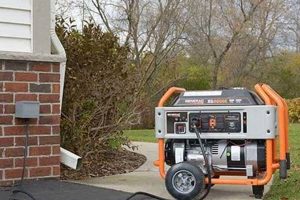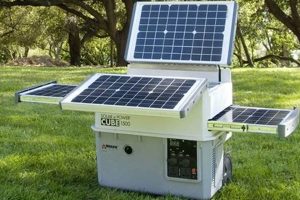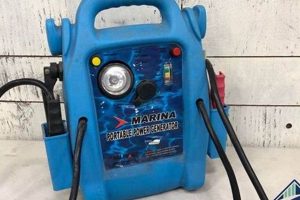Selecting a top-performing portable generator involves considering various factors, including power output, fuel efficiency, noise levels, runtime, portability features (such as weight and handle design), and specific power needs. For example, a camping trip might require a smaller, quieter generator, while powering essential household appliances during an outage necessitates a more robust option.
Reliable power access is crucial in numerous situations, from recreational activities and emergencies to professional applications. A dependable mobile power source offers peace of mind and enables uninterrupted operation of essential equipment when grid power is unavailable. The evolution of these devices has seen significant advancements in terms of fuel efficiency, noise reduction, and overall performance, making them increasingly valuable for a wide range of users.
This article delves deeper into key selection criteria, comparing various types and models to assist consumers in making informed decisions. Topics covered include detailed explanations of power ratings, fuel types, practical usage scenarios, maintenance tips, and safety precautions.
Tips for Selecting a Top-Performing Portable Generator
Choosing a suitable portable generator requires careful consideration of several factors to ensure optimal performance and satisfaction. The following tips offer guidance for navigating the selection process.
Tip 1: Assess Power Requirements: Calculate the total wattage required to operate the devices intended for connection to the generator. Consider starting wattage, which can be significantly higher than running wattage for some appliances.
Tip 2: Evaluate Fuel Options: Gasoline, propane, and inverter generators offer distinct advantages and disadvantages. Gasoline models are often more powerful, propane offers cleaner burning and longer storage life, while inverters provide quieter and more fuel-efficient operation for sensitive electronics.
Tip 3: Consider Runtime and Fuel Efficiency: Longer runtimes reduce refueling frequency. Fuel efficiency impacts operating costs and environmental impact. Examine specifications for fuel consumption rates and tank capacity.
Tip 4: Prioritize Noise Levels: Noise output can be a significant factor, particularly in residential or recreational settings. Look for models with lower decibel ratings for quieter operation.
Tip 5: Examine Portability Features: Weight, handle design, and overall dimensions influence ease of transport and storage. Consider the intended usage environment and choose a model with appropriate portability features.
Tip 6: Research Brand Reputation and Reviews: Reputable manufacturers often offer better quality, reliability, and customer support. Consult online reviews and product comparisons to assess user experiences and potential issues.
Tip 7: Plan for Maintenance: Regular maintenance, including oil changes and air filter cleaning, is essential for optimal performance and longevity. Consider maintenance requirements and accessibility when making a selection.
By considering these factors, consumers can select a portable generator that effectively meets their power needs, operating environment, and budget. A well-chosen generator provides reliable power access, enabling peace of mind and uninterrupted operation of essential equipment.
This guidance provides a foundation for making informed decisions. The subsequent sections will delve into specific generator types and models, offering further details to assist in the selection process.
1. Power Output
Power output, measured in watts, represents a critical factor in portable generator selection. Choosing a generator with appropriate power output ensures the ability to operate intended devices effectively. Insufficient power can lead to overloaded circuits and equipment damage, while excessive power represents unnecessary fuel consumption and cost.
- Starting Watts vs. Running Watts
Appliances require a surge of power upon startup (starting watts), which often exceeds their continuous operating power needs (running watts). Generators must accommodate both. For example, a refrigerator might require 1,800 starting watts but only 700 running watts. Failing to account for starting wattage can lead to generator overload.
- Total Power Requirements Calculation
Accurately assessing total power requirements necessitates summing the running watts of all intended devices and factoring in the highest starting wattage among them. This calculation ensures the generator can handle both continuous operation and startup surges without issue.
- Wattage and Appliance Types
Different appliance types have varying power demands. Sensitive electronics require cleaner power from inverter generators, while power tools may necessitate higher wattage from conventional models. Understanding these distinctions is crucial for appropriate generator selection.
- Power Output and Fuel Consumption
Higher power output generators generally consume more fuel. Choosing a generator with adequate but not excessive power output optimizes fuel efficiency and reduces operating costs.
Selecting a portable generator with appropriate power output ensures effective operation of desired appliances and prevents potential damage from overloading. Carefully assessing power requirements and understanding the distinctions between starting and running watts are essential steps in making an informed decision. This foundational understanding of power output contributes significantly to determining the most suitable portable generator for specific needs.
2. Fuel Efficiency
Fuel efficiency plays a crucial role in determining the overall effectiveness and cost-effectiveness of a portable power generator. A fuel-efficient generator reduces operating expenses, minimizes environmental impact, and extends runtime on a single tank, enhancing convenience and practicality. Understanding the factors influencing fuel efficiency enables informed decisions aligning with both budgetary and environmental considerations. For instance, a generator consuming less fuel for a given power output offers significant advantages during extended outages or remote applications where refueling is challenging.
Several factors influence generator fuel efficiency. Engine design and technology, including features like advanced combustion systems and variable speed control, contribute significantly. Operating the generator at the appropriate load level also impacts efficiency; running a significantly oversized generator at a low load can decrease fuel efficiency. Fuel type also plays a role; propane generators, for example, generally offer better fuel efficiency compared to gasoline equivalents, particularly at lower loads. Regular maintenance, including clean air filters and spark plugs, ensures optimal engine performance and contributes to efficient fuel consumption.
Selecting a fuel-efficient generator offers both immediate and long-term benefits. Reduced fuel consumption translates directly to lower operating costs, especially during frequent or extended usage. Improved fuel economy contributes to a smaller environmental footprint, lessening the impact of generator operation on air quality and greenhouse gas emissions. Moreover, extended runtime on a single tank enhances convenience, particularly in situations where refueling is challenging or impractical. Understanding the connection between fuel efficiency and selecting the best portable power generator empowers consumers to make informed choices that balance performance, cost, and environmental responsibility.
3. Noise Levels
Noise levels represent a critical factor in determining the suitability of a portable generator, particularly in residential areas, campsites, or work environments where noise pollution is a concern. Measured in decibels (dB), noise output significantly impacts user comfort and neighborly relations. Excessive noise can disrupt sleep, conversations, and the peaceful enjoyment of outdoor activities. Understanding the connection between noise levels and selecting the best portable generator involves considering the impact of noise on the surrounding environment and seeking models designed for quieter operation. For example, using a loud generator in a quiet neighborhood could lead to complaints, while a quieter model allows for peaceful coexistence.
Several factors contribute to generator noise levels. Engine design, exhaust systems, and overall construction play significant roles. Generators equipped with advanced mufflers and sound-dampening enclosures generally operate more quietly. Inverter generators, known for their variable engine speed, tend to produce lower noise levels, especially at lower loads, compared to conventional generators with fixed engine speeds. Operating the generator at a lower load often reduces noise output. Furthermore, placing the generator on a stable, non-resonant surface can minimize noise amplification. Manufacturers often provide decibel ratings, allowing consumers to compare models and choose options aligning with desired noise levels. Understanding these factors empowers informed decisions, balancing power needs with noise considerations. In practical applications, choosing a quieter generator ensures a more pleasant experience for users and minimizes disruption to the surrounding environment, showcasing the importance of noise levels as a key component in selecting the best portable power generator.
Selecting a portable generator with appropriate noise levels is essential for maintaining positive community relations, ensuring user comfort, and adhering to noise regulations in certain areas. Prioritizing quieter operation demonstrates consideration for others and enhances the overall experience of utilizing a portable power source. Understanding the factors influencing noise levels empowers consumers to make informed decisions and select the best portable generator for their specific needs, demonstrating a balance between power requirements and noise considerations.
4. Runtime
Runtime, representing the duration a portable generator can operate continuously on a single fuel tank, constitutes a critical factor influencing generator selection. Understanding runtime implications is essential for ensuring uninterrupted power supply across diverse applications. Whether powering essential appliances during an outage or providing electricity for recreational activities, aligning runtime capabilities with specific power needs is paramount. An extended runtime minimizes refueling frequency, enhancing convenience and ensuring sustained power availability. For instance, a generator with a longer runtime offers significant advantages during prolonged power outages or remote camping trips where refueling access is limited.
- Fuel Tank Capacity
Fuel tank capacity directly correlates with potential runtime. Larger tanks generally enable longer operation before refueling. A higher capacity tank reduces the frequency of interruptions for refueling, proving particularly beneficial during extended power outages or remote activities. However, larger tanks also contribute to increased generator size and weight, requiring consideration of portability needs.
- Fuel Consumption Rate
Fuel consumption rate, often expressed in gallons per hour (GPH), significantly influences runtime. Lower fuel consumption rates translate to longer runtimes on a given fuel tank capacity. Generators equipped with fuel-efficient engines and technologies maximize runtime and minimize operating costs. Comparing fuel consumption rates across different models aids in identifying options optimized for extended operation.
- Load and Runtime Relationship
The load placed on a generator directly impacts its runtime. Operating the generator at a lower percentage of its maximum power output typically extends runtime, while higher loads reduce operating time on a single tank. Understanding the relationship between load and runtime is crucial for effective power management and ensuring sustained operation within desired timeframes.
- Runtime and Application Specificity
Runtime requirements vary significantly depending on the intended application. Emergency backup power during extended outages necessitates generators with long runtimes, while powering recreational equipment for shorter durations might prioritize portability and fuel efficiency over extended runtime. Aligning runtime capabilities with specific usage scenarios ensures adequate power availability without unnecessary fuel capacity or cost.
Selecting a portable generator with appropriate runtime capabilities is fundamental for ensuring uninterrupted power availability tailored to specific needs. Balancing fuel tank capacity, fuel consumption rate, load considerations, and application-specific requirements enables informed decisions. Understanding the interplay of these factors empowers users to choose the best portable generator for their intended usage, optimizing power delivery and convenience while minimizing refueling interruptions.
5. Portability
Portability represents a defining characteristic of portable generators, directly influencing their usability and suitability across various applications. Evaluating portability involves considering factors that impact ease of transport, storage, and deployment in diverse environments. Understanding these factors is crucial for selecting the best portable power generator aligned with specific mobility needs. A lightweight, compact generator offers significant advantages for camping trips or outdoor events, while heavier-duty models might prioritize power output over ease of transport.
- Weight
Weight significantly impacts portability. Lighter generators are easier to maneuver and transport, particularly across uneven terrain or in situations requiring manual handling. For example, a lightweight generator proves beneficial for camping, tailgating, or other recreational activities, while a heavier generator might be acceptable for stationary emergency home backup power. Choosing the appropriate weight depends on the anticipated usage scenarios and individual physical capabilities.
- Size and Dimensions
Physical dimensions, including length, width, and height, influence storage and transport requirements. Compact generators occupy less space, simplifying storage in vehicles, sheds, or limited storage areas. Smaller dimensions also facilitate maneuverability in tight spaces. For instance, a compact generator is easier to transport in a car trunk compared to a larger, bulkier model. The intended storage and transport methods should guide size considerations.
- Handle and Wheel Design
Ergonomic handles and robust wheel designs enhance portability, facilitating easy movement and maneuverability. Well-designed handles provide a comfortable grip, reducing strain during transport. Durable, appropriately sized wheels enable smooth movement across various surfaces, including uneven terrain or gravel paths. For example, a generator with never-flat wheels offers greater mobility over rough terrain compared to one with smaller, less durable wheels.
- Folding Frames and Compact Designs
Features such as folding frames and compact designs contribute to enhanced portability and efficient storage. Folding frames reduce the overall footprint of the generator during storage and transport, optimizing space utilization. Compact designs, integrating components efficiently, minimize size and weight without compromising performance. These features prove particularly beneficial for users with limited storage space or frequent transport needs.
Careful consideration of portability factors ensures the selected portable generator aligns with specific mobility requirements and usage scenarios. Balancing weight, size, handle design, and compact features empowers users to select a generator optimized for easy transport, convenient storage, and seamless deployment in various environments. Understanding the connection between portability and selecting the best portable power generator contributes significantly to a satisfying user experience and effective power delivery wherever needed. Prioritizing portability streamlines transport and storage, making portable power more accessible and convenient across diverse applications.
6. Reliability/Durability
Reliability and durability represent critical factors in determining the long-term value and performance of a portable power generator. A reliable generator consistently delivers the expected power output when needed, while a durable generator withstands the rigors of operation and environmental exposure over an extended lifespan. Understanding the connection between reliability/durability and selecting the best portable generator involves evaluating factors contributing to robust construction, dependable performance, and long-term operational effectiveness. Investing in a reliable and durable generator ensures consistent power availability and minimizes the risk of unexpected failures, particularly during critical situations.
- Construction Quality and Materials
Robust construction, utilizing high-quality materials, significantly influences generator durability. Generators built with durable components, such as heavy-duty steel frames and weather-resistant enclosures, withstand demanding operating conditions and environmental exposure. For example, a generator with a reinforced frame and corrosion-resistant enclosure offers better protection against impacts and weathering compared to a model built with lighter materials. Choosing a generator built with quality materials contributes to a longer lifespan and reduced maintenance requirements.
- Engine Quality and Reliability
The engine represents the heart of a portable generator, directly impacting reliability and performance. High-quality engines, designed for demanding applications, deliver consistent power output and withstand extended operation. Reputable engine manufacturers often provide warranties and support, further enhancing reliability. For instance, a generator powered by a well-known, reliable engine offers greater assurance of consistent performance and longevity compared to a model equipped with a less established engine. Selecting a generator with a reliable engine ensures dependable power delivery and reduces the risk of unexpected failures.
- Maintenance and Service Requirements
Regular maintenance is essential for preserving generator reliability and durability. Generators designed for easy maintenance, with accessible components and clear maintenance schedules, simplify upkeep and promote long-term performance. readily available parts and accessible service centers further enhance reliability and minimize downtime. For example, a generator with easily accessible filters and spark plugs simplifies routine maintenance compared to a model requiring extensive disassembly for basic upkeep. Choosing a generator with manageable maintenance requirements contributes to sustained performance and longevity.
- Warranty and Customer Support
Comprehensive warranties and responsive customer support contribute significantly to the overall reliability and ownership experience of a portable generator. A robust warranty provides protection against manufacturing defects and premature failures, offering peace of mind to the consumer. Responsive customer support ensures prompt assistance with technical issues or warranty claims, minimizing downtime and maximizing generator availability. For instance, a generator backed by a comprehensive warranty and accessible customer support offers greater protection and peace of mind compared to a model with limited warranty coverage or difficult-to-reach customer service. Evaluating warranty and support options contributes to a more positive and reliable ownership experience.
Prioritizing reliability and durability in generator selection ensures long-term performance, minimizes downtime, and provides consistent power availability when needed most. Evaluating construction quality, engine reliability, maintenance requirements, and warranty/support options empowers consumers to make informed decisions, aligning their investment with long-term power needs and minimizing the risk of unexpected failures. Understanding the critical role of reliability and durability contributes significantly to choosing the best portable power generator for demanding applications and ensuring dependable power delivery over an extended lifespan. A reliable and durable generator represents a valuable investment, offering peace of mind and consistent performance in various situations.
Frequently Asked Questions about Portable Power Generators
This section addresses common inquiries regarding portable generator selection and usage, offering concise yet informative responses to facilitate informed decision-making.
Question 1: How is generator power output determined, and what does it signify?
Generator power output, measured in watts, indicates the amount of electricity a generator can produce. It’s crucial to select a generator with sufficient wattage to power intended devices. Running watts represent continuous power delivery, while starting watts cover the initial surge required by some appliances.
Question 2: What distinguishes inverter generators from conventional generators?
Inverter generators produce cleaner, more stable power suitable for sensitive electronics. They adjust engine speed based on load, leading to improved fuel efficiency and quieter operation compared to conventional generators with fixed engine speeds.
Question 3: What factors influence generator runtime, and how can runtime be maximized?
Runtime depends on fuel tank capacity, fuel consumption rate, and the load placed on the generator. Maximizing runtime involves operating the generator at a lower load and utilizing fuel-efficient models with larger fuel tanks.
Question 4: What safety precautions should be observed when operating a portable generator?
Safe operation requires adequate ventilation to prevent carbon monoxide buildup. Generators should never be operated indoors or in enclosed spaces. Proper grounding and connection procedures are essential to prevent electrical hazards.
Question 5: How does one determine the appropriate generator size for specific needs?
Calculating total power requirements involves summing the running watts of all intended devices and factoring in the highest starting wattage among them. This calculation ensures the generator can handle both continuous operation and startup power demands.
Question 6: What maintenance procedures are recommended for optimal generator performance and longevity?
Regular maintenance, including oil changes, air filter cleaning, and spark plug replacement, is essential for maintaining optimal performance and extending generator lifespan. Consulting the manufacturer’s maintenance schedule ensures appropriate upkeep procedures.
Understanding these key aspects of portable generators empowers informed decisions aligning power needs with specific applications and operating environments. Careful consideration of these factors contributes significantly to a safe and satisfying generator ownership experience.
For further information regarding specific generator models and technical specifications, please consult the subsequent sections dedicated to in-depth product reviews and comparisons.
Finding the Best Portable Power Generator
Determining the optimal portable generator involves careful consideration of various interconnected factors. Power output, fuel efficiency, noise levels, runtime, portability, and reliability/durability each contribute significantly to overall performance and suitability for specific applications. Balancing these factors against individual power needs, budgetary constraints, and environmental considerations is crucial for informed decision-making. No single “best” generator exists universally; rather, the ideal choice depends on the specific circumstances and priorities of the user.
Careful evaluation of these critical aspects empowers consumers to select a portable generator that effectively meets their power requirements while aligning with practical considerations and long-term value. Investing in a well-chosen portable generator provides access to reliable power, enhancing preparedness for emergencies, facilitating recreational activities, and supporting professional applications. Empowered by knowledge and informed decision-making, consumers can harness the potential of portable power to enhance their lives and navigate power-dependent situations with confidence.






